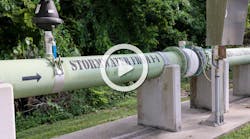EPA Announces Winners of its Annual Campus RainWorks Challenge
The U.S. Environmental Protection Agency (EPA) announced the winners of its tenth annual Campus RainWorks Challenge, a national competition that engages college students in the design of on-campus green infrastructure solutions to address stormwater pollution. This year’s winning projects showcase the environmental, health, economic, and social benefits of green infrastructure.
"I congratulate Cornell University students for winning the EPA's Campus RainWorks Challenge. Cornell students are tomorrow's designers, planners, and innovators of green infrastructure, vital to protecting water quality in Cayuga Lake for the community and wildlife," said Regional Administrator Lisa F. Garcia. "Through EPA's Campus RainWorks Challenge, we encourage enthusiastic and creative students to work closely with their local communities to solve local stormwater problems and better protect water resources from harmful stormwater pollution."
“Green infrastructure is essential to building dynamic and thriving communities. When we apply green infrastructure strategies—like those exemplified by the Campus RainWorks winners—projects can meet community needs while supporting clean water goals,” said EPA Assistant Administrator for Water Radhika Fox. “The timing of this competition couldn’t be better, as we celebrate Water Week 2022, the 50th anniversary of the Clean Water Act, and begin to implement the Bipartisan Infrastructure Law. I would like to congratulate this year’s winners and I want to thank the faculty and thousands of students, past and present, that have endeavored to improve their community through Campus RainWorks.”
EPA’s Campus RainWorks Challenge invites students and faculty members at colleges and universities to apply green infrastructure design principles, foster interdisciplinary collaboration, and increase the use of green infrastructure on the nation’s college campuses. This year, 42 teams from across 24 states and 35 different academic institutions competed in the Campus RainWorks Challenge’s two design categories. The Master Plan category examines how green infrastructure can be broadly integrated across campus while the Demonstration Project category focuses on how green infrastructure can address stormwater pollution at a specific site on campus.
This year’s winners are:
Florida International University (1st Place Demonstration Project Category) – The team’s entry, titled “Resilient MAST @ FIU” redesigned a local magnet high school campus to incorporate a variety of green infrastructure practices with the goal of improving water quality, reducing urban heat island effects, and mitigating the risk of coastal flooding due to climate change. The team engaged with local stakeholders and conducted sophisticated performance modeling to produce design solutions that would not only benefit the local campus and community but serve as a replicable example for other coastal educational institutions. Watch the team’s video about their design on Youtube.
University of Maryland (1st Place Master Plan Category) – In their entry titled “Future Flows,” this team emphasized the beneficial role green infrastructure can play along transportation and pedestrian corridors. By examining current and predicted fluctuations in the movement of people and water across campus, the team’s design would revitalize the campus through restoration of site hydrology and create a more resilient and adaptable campus for future generations of students. Watch the team’s video about their design on Youtube.
Cornell University (2nd Place Demonstration Project Category) – Titled “Rain Delay,” this entry took advantage of campus plans to construct new computer science facilities to illustrate the potential benefits of green infrastructure. The team consulted with campus experts in architecture, engineering, facilities management, and ecology to design green infrastructure solutions that would protect water quality in nearby Cayuga Lake, promote resilience, create new wildlife habitat, and create new recreational and educational opportunities for students and educators. Watch the team’s video about their design on Youtube.
University of Connecticut (2nd Place Master Plan Category) – The “Ecologic L.I. Sound” entry redesigned the university’s Avery Point campus to mitigate the effects of stormwater pollution on the terrestrial and marine ecology of Long Island Sound. Selected green infrastructure practices emphasized the importance of native species that represent the distinctive character of coastal plant communities. In addition to protecting public health, water quality, and local ecology, the design would create collaborative educational spaces that invite students and the public to learn about the role green infrastructure can play in stormwater management and coastal resilience. Watch the team’s video about their design on Youtube.
EPA is also pleased to recognize the University of Pennsylvania, the University of Maryland, the University of Illinois, and the University of Arkansas for honorable mention in the Demonstration Project category. Utah State University, the University of Portland, and Michigan State University were selected for honorable mention in the Master Plan category.
First place teams will receive a $7,000 student prize to be split among team members and a $3,000 faculty prize to support green infrastructure research and training. Second place teams will receive a $3,500 student prize and a $1,500 faculty prize.
Since 2012 nearly 800 teams have participated in the Campus RainWorks Challenge. View previous winners and teams here: Explore 10 Years of Campus RainWorks.


